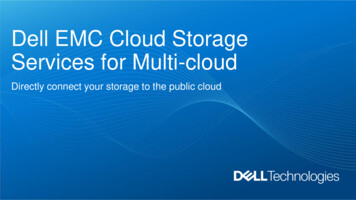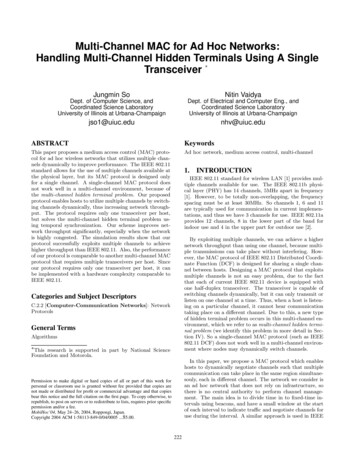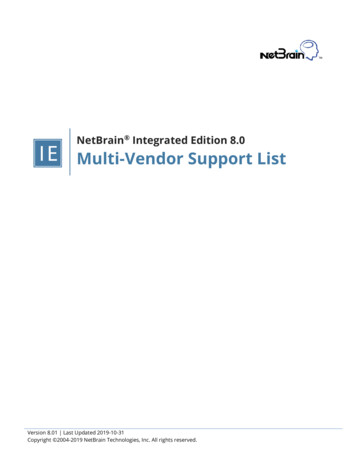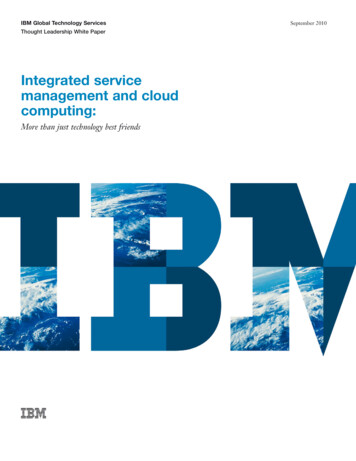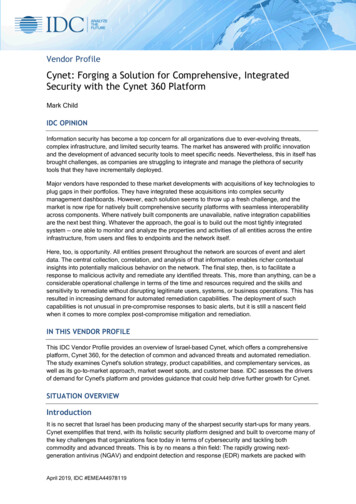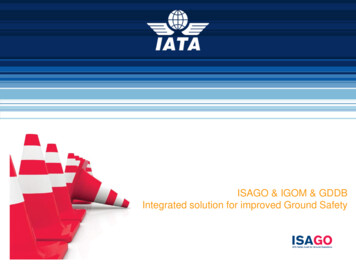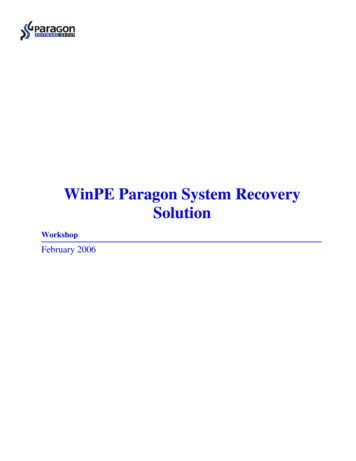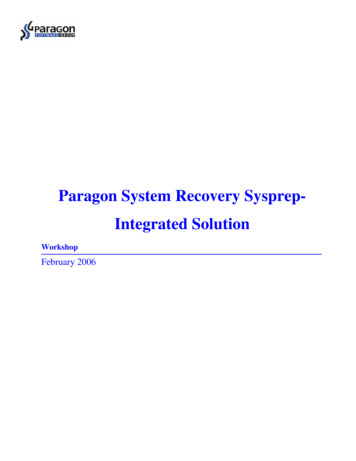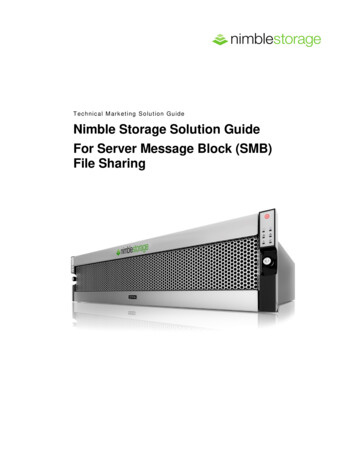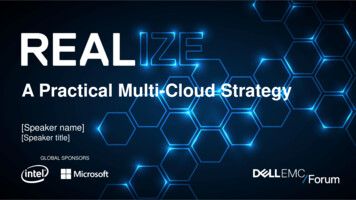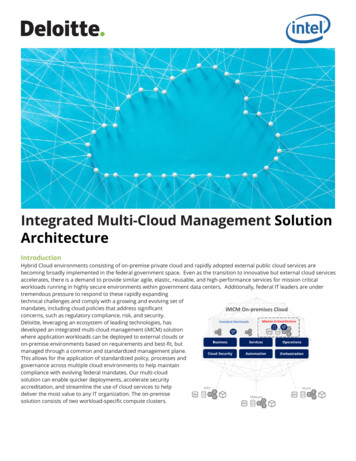
Transcription
Integrated Multi-Cloud Management SolutionArchitectureIntroductionHybrid Cloud environments consisting of on-premise private cloud and rapidly adopted external public cloud services arebecoming broadly implemented in the federal government space. Even as the transition to innovative but external cloud servicesaccelerates, there is a demand to provide similar agile, elastic, reusable, and high-performance services for mission criticalworkloads running in highly secure environments within government data centers. Additionally, federal IT leaders are undertremendous pressure to respond to these rapidly expandingtechnical challenges and comply with a growing and evolving set ofmandates, including cloud policies that address significantconcerns, such as regulatory compliance, risk, and security.Deloitte, leveraging an ecosystem of leading technologies, hasdeveloped an integrated multi-cloud management (iMCM) solutionwhere application workloads can be deployed to external clouds oron-premise environments based on requirements and best-fit, butmanaged through a common and standardized management plane.This allows for the application of standardized policy, processes andgovernance across multiple cloud environments to help maintaincompliance with evolving federal mandates. Our multi-cloudsolution can enable quicker deployments, accelerate securityaccreditation, and streamline the use of cloud services to helpdeliver the most value to any IT organization. The on-premisesolution consists of two workload-specific compute clusters.
Overview of the Hybrid Cloud Mission Critical Enclave ArchitectureThe Hybrid Integrated Multi Cloud Management solution coupled with the Mission Critical Enclave (MCE) capability offersperformance, security, and operability by integrating advanced hardware and software components from IT market leaderswith the industry knowledge of professional services. Deloitte has developed and benchmarked the Hybrid Integrated MultiCloud Management solution described below and as such we are including the specific technologies to provide context tothat baseline. The four layers of the iMCM MCE core stack, depicted below, are further explained in the following sections.InfrastructureThe infrastructure layer, containing the compute, storage, and network components of the Hybrid Cloud MCE, leverages thefollowing readily available hardware selections:ComponentDescriptionDell PowerEdge R640Rack Mounted ServersEnables dense scale-out data center computing and storage through a dual-socket platform that alsoprovides embedded diagnostics and SupportAssist. In the reference configuration, each server has beenconfigured with 6 – 1.46TB high performance NVMe SSDs and 2 – 350GB state-of-the-art Optane drivesfor superior performance.Provides Intel’s advanced hardware-enhanced reliability, availability and serviceability (Advanced RAS)and is highly scalable to support a wide range of existing workloads for a modern hybrid cloud businessstrategy. Built on 14 nm process technology and configured with 10 cores/20 threads per socket forincreased performance, the Intel Xeon Gold 5115 has a Processor Base Frequency (Clock speed) of 2.40GHz with capability to reach 3.2GHz at Max Turbo Frequency.Enables secure system start-up processes and is leveraged by Intel TXT to store measurements (hash ofcomponents) of the platform. The advanced features of TPM enable the measurement, storage,encryption and reporting of the current state of the platform data.Enables inter-server connectivity required for vSAN operations. Each server is equipped with 2 QSFPports which provide high availability and allow for multi-pathing.Intel Xeon Gold 5115ProcessorIntel Trusted PlatformModule (TPM)Intel 40Gbps QuadSmall Form-factorPluggable (QSFP)Intel Optane SSD DCP4800X2Supports the storage tier with dual cards and features 3D XPoint memory media, which utilizes theproperty- change of the memory material itself, to store the data and when coupled with Intel-developedcontroller and firmware, helps take SSD performance to the next level.
SDDCThe Software Defined Data Center (SDDC) layer on top of the infrastructure provides abstraction between the operatingsystem, applications, and hardware. While traditional storage and network implementations require complex, proprietary,costly infrastructure and labor resources with often difficult to find skill-sets, SDDC enables organizations to simplify themanagement of their compute, storage and network through the following solutions: vSphere provides a powerful, flexible, and secure foundation for business agility that can accelerate the digitaltransformation to hybrid cloud and success in the digital economy. It helps run, manage, connect and secureapplications in a common operating environment across the hybrid cloud. With vSphere, iMCM can support newworkloads and use cases while keeping pace with the growing needs and complexity of infrastructure. vSAN delivers flash-optimized, secure shared storage with the simplicity of a VMware vSphere-native experience forall critical virtualized workloads. vSAN 6.7 is architected for the hybrid cloud with operational efficiencies that reducetime to value through an intuitive user interface and provide consistent application performance and availabilitythrough advanced self-healing and proactive support insights. Seamless integration with VMware’s complete SDDCstack and leading hybrid cloud offerings makes it one of the most complete platform for virtual machines—whetherrunning business-critical databases, virtual desktops or next-generation applications. NSX is the network virtualization platform for the SDDC, delivering networking and security entirely in software,abstracted from the underlying physical infrastructure. NSX Data Center enables the Virtual Cloud Network,providing pervasive, end-to-end connectivity and security for apps and data through micro segmentation and policybased network configurations.3
iMCMThe Multi-Cloud Management stack consists of several integrated layers, each one providing a specific set of capabilities,which are complementary to the overall solution. These solution layers work in conjunction with the orchestration platformand the hardening environment to deliver iMCM’s value. Each solution layer is summarized in the points below: The Business Management layer facilitates informed decision making. This layer includes the tool set that providestransparency and control over the costs and quality of IT services, enabling the decision makers to align IT with themission by comparing the costs of workloads between the private cloud and multiple public clouds. The Service Management layer provides a common unified portal to allow users with role-based authorizationto request IT Services across clouds. It includes a workflow management and automation capability toimplement a service catalog and governance that spans the entire multi-cloud operational environment in amanner that is streamlined for the user. The Operational Management layer offers a single pane of glass command and control panel, which providesoperations staff cloud administration, performance monitoring/tuning, risk mitigation, and troubleshootingcapabilities. The Automation layer provides consistent deployment and management of IT services while reducing manualprocesses and helping to limit human error and ensure compliance with policies. Automation enables significantoperational efficiencies by reclaiming inactive resources that may be repurposed to other applications based ondynamic mission demands. The Orchestration platform enables the automation of complex IT tasks to adapt and extend service delivery andoperational management across clouds. The orchestration platform is the engine by which the Automation andOperational Management layers provide deployment, remediation and adherence to industry- standards and/ororganizational policies. Additionally, it includes the ability to automate and orchestrate with PaaS, SaaS, andServerless/Containers/Microservices. Hardening and Security Management for the Hybrid Cloud Mission Critical Enclave is implemented through a suiteof leading technical products that can effectively meet agency hardening guidelines and control requirements andenables strong security management for workloads in both public and private clouds. These managementtechniques leverage best practices in Cloud Business Management, Data Encryption/management, PrivilegedAccount Management, Password Vaulting, and Cross-cloud security threat detection and mitigation to provideeffective security in an elastic environment, multi-cloud ecosystem.4
Mission Critical Enclave SecurityDeloitte’s Multi-Cloud Management enforces control and governance from the physical hardware up through the applicationsoftware, and several layers in between them: Intel’s Trusted Platform Module securely stores keys, passwords and digital certificates in onboard microcontrollers andTrusted Execution Technology is a hardware extension that attests application authenticity and protects againstsoftware-based attacks while protecting the confidentiality and integrity of data stored and created on servers. Software Defined Networking implements VLANs and microsegmentation along with selective firewalling of datatransiting networks internally as well as externally. Additionally, all traffic is secured with encryption keys andauthorized certificates both internally between servers, and externally thru encrypted VPNs to any CSP extension, andresources therein. Virtualization host servers are built hardened and protected with an audited, rotated, single-use strong passwordcontrol system for access. Operating System Virtual Machine gold images are built and deployed to DISA STIGspecification. Compute Workloads are provisioned automatically to a Zero-Trust model, adhering to appropriate placement andaccess policies are restricted or allowed, as necessary. Notable iMCM product suites that actively govern security policies are HyTrust Boundary Control and an enterprise-class security suite (such as McAfee EPO, Microsoft ASM, of or Symantec SEP solutions) covering Cloud Security, DataProtection and Encryption, Endpoint Protection all managed through automated orchestration. Software-Defined Data Center operational maintenance is controlled by a dedicated Lifecycle Manager which keeps allvirtual infrastructure components up to date, patched, and interoperable by its compatibility matrix. Cloud Native Platform as a Service lays groundwork for agile containerized applications and services lending itself toadditionally resilient and granular affinity and anti-affinity policy control. Compliance is monitored constantly with multiple tools in both Security and Operational modules with ability toprogrammatically quarantine misaligned resources and remove threats. Data Protection is maintained though server and storage clustering, hardware and/or software backup appliancetechnology, virtualization data protection and replication of defined application groups to accommodate desiredDisaster Recovery and Business Continuity RTO/RPO policies.Advanced Security through Threat Identification and ProtectionDeloitte’s Multi-Cloud Management is designed to provide defense across the multiple layers of the mission critical enclave,securing from the hypervisor (SDDC) all the way through the application layer. Described below are the advanced threatdefense suite of products that were utilized as part of our benchmarking. Our approach to providing advanced security istechnology agnostic and Deloitte would tailor this solution to reflect the client’s choice of security providers as part of theirexisting and planned system architecture.Security FeatureDescriptionCentralized Management ConsoleComponent for supporting products within the installation, software management and deployment, and reporting.The console managed the systems topography and is required to support the data center infrastructure.Provides network security management and protection for the enclave. This component combines intelligent threatprevention at the network layer and extends it beyond intrusion, matching signatures with layered signature-lessand emulation technologies.Network Security PlatformCloud Security ComponentAllows the discovery, import, management and securing of all cloud-based infrastructure such as AWS, Azure, andVMWare vCenter. Offers improved visibility and control to address the unique requirements of public cloud serversecurity.Advanced Threat ProtectionThis component goes beyond traditional sandboxes to deliver broader protection and expose evasive, well-hiddenattacks. Drawing on the tight integration from the network to the endpoint, it instantly shares information across theenvironment to accelerate threat investigation and protect the mission.Enables collective learning across the defense fabric to neutralize emerging threats more quickly.Threat Intelligence Sharing Network5Policy AuditorProvides the tool for compliance auditing and reporting on the asset portfolio, vulnerabilities, and configurations ofthe enclave.Data Loss Prevention (“DLP”) PlatformSuite of products designed to protect various data types as they move through the network. The platform consists of: DLP Endpoint – Centrally managed policies to control the use and transfer of sensitive data and providedetailed forensic reports. Device Control – Comprehensive device management to help control and block the exfiltration of confidentialdata through removable storage or similar means. DLP Discovery – Performs file scans and collection jobs to search endpoints, servers, Box, SharePoint, anddatabase repositories to identify and protect sensitive data. DLP Prevent – Works with web proxies and mail transport servers to protect web and email traffic. DLP Monitor – Passively scans unencrypted network traffic for potential data loss incidents.
Benchmarking PerformanceThe advanced performance capabilities of the hybrid cloud MCE have positioned it to be a preferred solution for computeand IO-intensive critical workloads. Whether running advanced analytics on extremely large data sets or enabling securitydriven workloads to get cloud-like performance in on-premise environments, the hybrid cloud MCE can perform at thehighest tier. For example, our tests using a high-performance compute cluster of Dell EMC and Intel technologies previouslymentioned demonstrated significant performance improvement over a standard compute cluster when runningbenchmarking stress tests using tools like TestDFSIO, Teragen and Terasort. The findings below further support the hybridcloud MCE’s compute performance:TeraSort Hadoop BenchmarkTest: Performance Cluster wrotedata to disk 3.5 times faster andsorted thedata 2.5 times faster than theStandard Compute ClusterTestDFSIO Test: Throughputincreased 4 to 5 times when writingto disk and 2 times when reading atvarying data loads on theperformance cluster. The AverageIO found from the TestDFSIO testalso showed that writing to diskincreased 4 to 5 times and diskreads increased 2 times on theperformance cluster at varying dataloads and a replication factor of 3.These diagnostic evaluationsillustrate that any IO intensiveworkload, like aggregating datareceived fromin-field IoT devices and then storingthe continuous data stream prior torunning analytics tools, such as Hiveor Spark, should be targeted towardsthe MCE high-performance computecluster. With this ability, predictiveanalytics can identify and remediateissues prior to failure and disruptionto services. The figures summarizetest results.ConclusionThe iMCM solution features a robust hybrid framework that provides a flexible multi-cloud management toolset,including a service and organizational component that delivers capabilities across on-premise and public infrastructure.Through iMCM, disparate cloudecosystems are tied together into one common cloud management solution to deliver a comprehensive view and maintainoperational control of resources and workloads running across multiple cloud service providers. The iMCM Mission CriticalEnclave is the vital component of the solution that enables customers to run highly secure and highly compute and IO intensiveworkloads on premises while achieving exceptional performance results. As the above performance benchmarking resultsdemonstrate, the MCE based on this reference architecture can provide significant mission benefits for processing of verylarge datasets and high intensity analytics in very secure environments. With Hybrid iMCM, IT organizations can view andmanage IT workloads across cloud providers and on- premise environments to achieve cost, security, and performance6
benefits.Let's TalkReach out to our team to request a demo and learn more about how iMCM MCE can help you transform your organization.Contacts:Doug BourgeoisManaging DirectorDeloitte Consulting LLPdbourgeois@deloitte.com 1.571.814.7157Sean VanDruffSenior Technology FellowDeloitte Consulting LLPsvandruff@deloitte.com 1.215.446.4314Thomas HenrySenior ManagerDeloitte Consulting LLPthhenry@deloitte.comAs used in this document, “Deloitte” means Deloitte Consulting LLP, a subsidiary of Deloitte LLP. Please see www.deloitte.com/us/about for a detaileddescription of our legal structure. Certain services may not be available to attest clients under the rules and regulations of public accounting.This publication contains general information only and Deloitte is not, by means of this publication, rendering accounting, business, financial, investment,legal, tax, or other professional advice or services. This publication is not a substitute for such professional advice or services, nor should it be used as abasis for any decision or action that may affect your business. Before making any decision or taking any action that may affect your business, you shouldconsult a qualified professional advisor. Deloitte shall not be responsible for any loss sustained by any person who relies on this publication.Copyright 2018 Deloitte Development LLC. All rights reserved.7
The Multi-Cloud Management stack consists of several integrated layers, each one providing a specific set of capabilities, which are complementary to the overall solution. These solution layers work in conjunction with the orchestration platform and the harden
